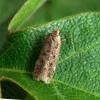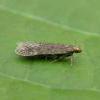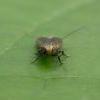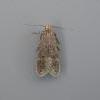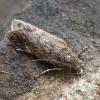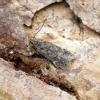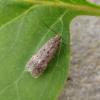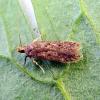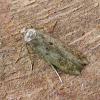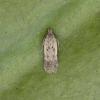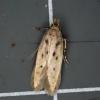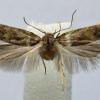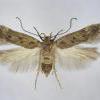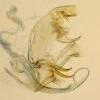35.046 Bryotropha senectella (Zeller, 1839)
Status and Distribution
Locally common over much of England, becoming more local in south-west and northern England, western Wales, Scotland, Isle of Man, Ireland and Northern Ireland. Rare on the Channel Islands and apparently absent from the Outer Hebrides and Northern Isles.
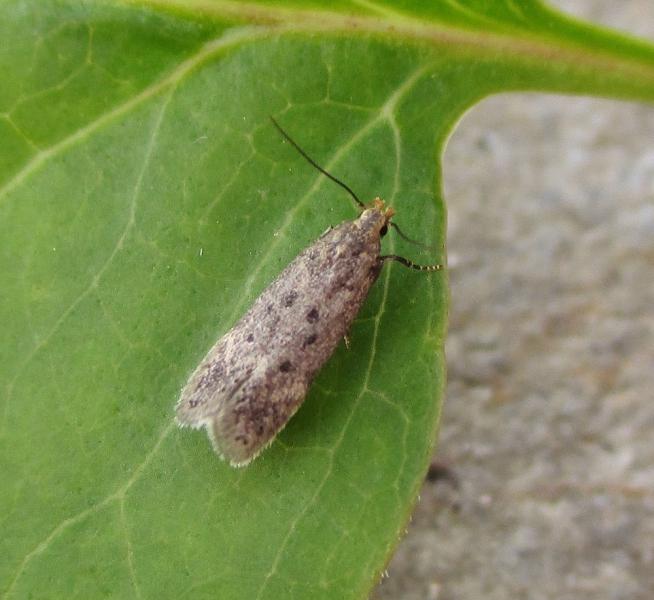
Provisional map
Pupa
Set Specimens
The Chandlers Ford specimen (top left) illustrates some of the variation that can occur within this species both in forewing markings and in parts of the male genitalia (above). Note the shape of the gnathos which is broader at the base and shorter overall than is usual, but within the range of variation depicted in Karsholt and Rutten, 2005.
Foodplant and Larval Feeding Signs
Homalothecium lutescens (yellow feather-moss), see distribution map, with an open structure growing on the ground or low rocks and a Bryum sp. with a rather more dense structure on walls. See Heckford and Sterling, 2002 for more details.
The larva feed in semi-transparent whitish silken tubes about two to three times the length of the larvae. The tubes are not very sturdy and do not incorporate fragments of moss or grass but can be found on the surface of the moss often descending into the substrate.
Habitat
Inland areas inhabitated have not been detailed and any comments on this would be appreciated. Also on sandy coasts, particularly favouring herb-rich coastal dunes and slacks.
Finding the Moth
Larva: on low rocks and walls, occasionally also on the ground, feeding in semi-transparent whitish silken tubes about two to three times the length of the larvae. The tubes are not very sturdy and do not incorporate fragments of moss or grass but can be found on the surface of the moss often descending into the substrate.
Adult: can be swept from grassy herb-rich coastal dunes in sunshine and warm, cloudy evenings and comes to MV light. Females have been found nectaring in numbers on Senecio jacobaea (ragwort) in coastal areas as dusk approaches and several of unspecified sex probably feeding on Leucanthemum vulgare (oxeye daisy) flowers at about 7.30pm at the end of June. On 2.7.2020 found nectaring on Heracleum sphondylium (hogweed) in VC98 D. Jardine per D Hill.
Similar Species
One of the smaller Bryotropha species with a wingspan of 9 - 12.5mm. The forewing is quite variable in colour from pale straw-brown to dark brown and varies in having a fairly prominent angled subterminal fascia to no fascia at all. It lacks the contrasting paler forewing and dark heavy speckling of the similar sized B. basaltinella and B. dryadella and is brown rather than blackish distinguishing it from the dark form of B. umbrosella. B. senectella often has the a slightly darker line or band running through the middle of the head (vertex) in most, but not all individuals which contrasts with the paler cheeks. In dark forms, the usually pale yellow labial palpus and frons (which can be sprinkled with ochreous) may help distinguish it from the larger B. similis, which is creamy white in this area. Dissection is recommended with worn specimens or where the markings are obscure.
Darker forms might be confused with faintly marked or worn B. affinis but lack any hint of whitish yellow scaling around the central black spots. Generally B. affinis usually has a darker top to the head (vertex) but on occasions it can be creamy in colour. As a result, the darker line on the head of B. senectella, which varies in width and intensity, is best not used as a single identification feature.
Single brooded from late June to early September.
Earliest: 21st May 2010 (VC31)
Latest: 24th September 1994 (VC66)

